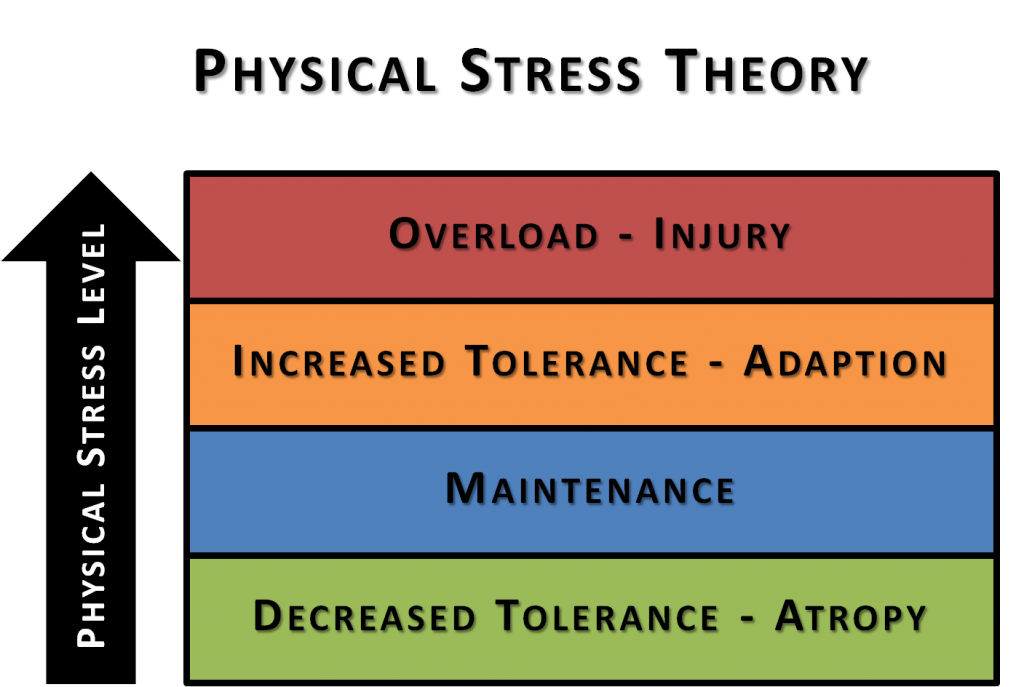The 10% Rule
A common rule that has become widely accepted is the 10% rule. This is a general guideline to help prevent injuries. The rule simply states that you should not increase your duration, frequency, intensity, or load by more than 10% per week. Failing to abide by this rule can lead to maladaptive compensations, tissue overload, subsequent injuries, and a possible loss of that rug that really ties the room together.
Just Take it Easy, Man
Whether you’re trying to increase your bowling average or how much you bench press, you need to first break down (stress) your muscles before you they build back up stronger. This is pretty much the basis behind the Physical Stress Theory and the SAID principle. To make gains you have to push hard enough to where the body is forced to adapt to the new demands placed on it. The problem comes when people push too far and are out of their element. The body cannot adapt and injury occurs. This is a bummer, man.
How to Apply it
Using the 10% rules helps to ensure that you won’t push yourself past the adaption stage and into the injury stage. Examples of ways to use it:
- Running 20 miles a week, increasing to 22 miles the following week
- Bench pressing 15 reps of 135lbs, increasing to 17 reps of 135 the following week
- Practicing guitar for 40 minutes, increasing to 44 minutes the following week
- Drinking 10 White Russians a day, increasing to 11 White Russians a day the following week
Don’t Let This Aggression Stand
Of course this is just a simple guideline. Everyone has different thresholds and tolerance levels. Depending on your level of experience with the task you are performing you can adjust your progression accordingly. If you’re looking to break records, the 10% rule may be too conservative. However, if you’re just looking to stay injury free, then the 10% rule is a great guideline to abide by.
Also note that this isn’t a 10% increase between sessions, it assumes you are performing the activity a couple times a week. The Dude wouldn’t be rolling straight if he didn’t build his tolerance throughout the week. And keep in mind that if you are having pain during or after the activity you are already in the overload-injury level and probably need to dial it down some.
Even though this is a simple rule and seems like common sense, I have clinically seen more patients injure or re-injure themselves by doing too much, too soon. The classic example is the knee patient that is feeling much better and decides to increase from 1 mile to 2 miles in just one session. This is a 100% increase! Like Donny, this patient is out of his/her element and are most likely overloading the tissues too much.
So next time try not to be an overachiever and just abide by the 10% rule, man.
—
The main reason I do this blog is to share knowledge and to help people become better clinicians/coaches. I want our profession to grow and for our patients to have better outcomes. Regardless of your specific title (PT, Chiro, Trainer, Coach, etc.), we all have the same goal of trying to empower people to fix their problems through movement. I hope the content of this website helps you in doing so.
If you enjoyed it and found it helpful, please share it with your peers. And if you are feeling generous, please make a donation to help me run this website. Any amount you can afford is greatly appreciated.





What a small world 🙂 Teaching a component on Physical Stress Theory and look who I found!! Hope your doing well; give me a call some time; love to catch up!!
404-630-6148
Jim